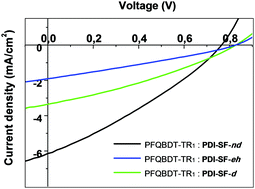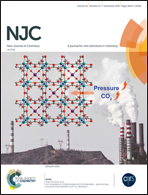Side chain modification on PDI-spirobifluorene-based molecular acceptors and its impact on organic solar cell performances†
Abstract
N-Substitution in perylene diimide (PDI) n-type semiconductors is critical for their performance in organic bulk heterojunction solar cells. In this work we synthesized and compared three perylene diimide-spirobifluorene derivatives, N-substituted with different alkyl side groups. These molecular systems were obtained by cost-effective methods, using straightforward synthetic procedures and easy purification. These PDI derivatives were used as electron acceptor materials, blended with a benchmark quinoxaline–benzodithiophene based donor polymer, in bulk heterojunction solar cells. All devices were processed by blade coating in air, and also using non-chlorinated solvents. The three molecules presented identical HOMO/LUMO energy levels and very similar optical properties but different photovoltaic responses. These different performances were discussed through optical, electrical and morphological characterizations. The highest power conversion efficiency was achieved for the active layer based on the derivative with branched and longer alkyl groups in N-positions, which favored a morphology with reduced donor:acceptor phase segregation.



 Please wait while we load your content...
Please wait while we load your content...